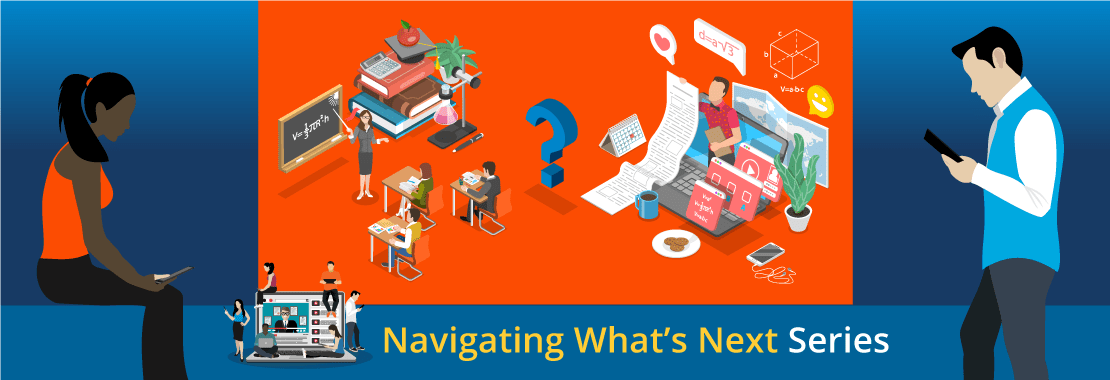Article Summary
- HyFlex Course Model: In short, it's a combo of online and classroom-based learning.|HyFlex How-To: Maintain communication with your students, starting on day one. |HyFlex How-To: Make learning activities engaging—your students will thank you. |HyFlex How-To: Foster meaningful discussions to build critical-thinking skills.
- field_5cf83622ba22e
- field_5cf83622ba22e
Essie Childers is a Professor of Student Success at Blinn College in Bryan, Texas.
COVID-19 has accelerated digitalization, promoting conversations of different learning pathways for students. Educators must find creative ways to engage students in the classroom as well as in an online environment. The landscape of higher education will never be the same, and the delivery of instruction will take on a new look.
There are many scenarios to consider, such as, face-to-face, blended, HyFlex or fully online classes. Should classes be accessible in a four-, eight-, 12- or 16-week format? In considering physical distancing and the limitations of the number of students in a classroom, a HyFlex model may be a good fit for many institutions.
What is a HyFlex Model?
In describing a HyFlex class, you may receive different interpretations depending on the institution. According to TeachThought, HyFlex involves combining elements of both online and classroom-based learning; HyFlex takes hybrid classes to a new level of flexibility. Students can choose to take classes online, head to the classroom or do both, giving them the freedom to study when and where they want based on their own needs, desires and preferences.
Using a HyFlex Model, faculty should consider three success strategies to help students have a successful class experience: 1) Communication with students; 2) Engaging student learning activities; and 3) Meaningful discussion posts.
Strategy: Communicate with Your Students
Success begins before the first day. From the class roster, you can retrieve email addresses to send a “Welcome Letter” to students. Personalize the letter by addressing the student by their first name. Don’t assume your students know how to access email—tell them. If there is a preferred method of communication for you, be sure to list your contact information. An introduction email sets the stage for success before the first day and makes each student feel special.
Throughout the semester, send Motivational Monday Videos to give students a brief snapshot or menu of the week. Begin with a few seconds of music to lift their spirits followed by a few narrated slides. Share something about your weekend to display your human side. It’s OK to laugh. Be you.
Use bullet points, and keep the video to under three minutes. End with a motivational quote for later meta-reflection. Ask students to send clips of music and motivational quotes for you to use. Monday Motivational Videos are one way to engage and send “I Care” messages.
Strategy: Incorporate Engaging Learning Activities
Use a worksheet to plan student learning activities. Consider your in-class activity and how one can replicate the activity online. For example, contemplate the learning outcome in which students identify characteristics of successful learners and factors that impact learning. Students can read the case study silently, jot down elements of successful traits and share their findings with a student or the class.
Remote students can gather in an online breakout room to analyze the case study and report their findings to the class as well. This active-learning activity is commonly known as Think-Share-Pair.
“Student Teach Another” is one of my favorite activities in which I pair students and assign a section of the chapter for them to teach. Presentations will occur during face-to-face or in-person classroom time. Student Teach Another encourages the student to read the chapter and collaborate with their peers.
Strategy: Encourage Meaningful Discussion Posts
Discussion posts play a vital role in developing a HyFlex course and can be a conversation starter at the beginning of class. Since discussion posts allow students to have an uninterrupted space to write, make the posts meaningful to foster critical thinking. One of my favorite discussion posts involves posting an article for students to read, reflect and respond to in the form of SPUNKI.
SPUNKI is an acronym which asks students to identify a concept in the article that was Surprising, Puzzling, Useful, New or Interesting to them. The instructor may ask the student to post an article of their own choice and allow peers to complete the SPUNKI chart. Through meaningful discussion posts, I can truly tell that my students are engaged, and neurons are firing together, creating other neural networks (Childers, 45).
The HyFlex model will require instructors to be creative in organizing the student’s learning path in order to meet instructional objectives. However, communicating with your students, incorporating engaging learning activities and encouraging meaningful discussion posts are all strategies to foster student success in any environment, including HyFlex.
To gather more tips and ensure you’re ready for success with your course model this fall, check out our Empowered Educator professional development series.
Reference: Childers, Essie. “Promote Critical Thinking Through Online Discussion Forum.” CASP, Vol. 1, no. 2, Fall 2018, pp. 45-46.

